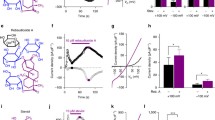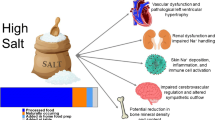Abstract
High salt intake is a known risk factor of cardiovascular diseases. Our recent study demonstrated that long-term high salt intake impairs transient receptor potential channel M5 (TRPM5)-mediated aversion to high salt concentrations, consequently promoting high salt intake and hypertension; however, it remains unknown whether TRPM5 activation ameliorates cardiovascular dysfunction. Herein we found that bitter melon extract (BME) and cucurbitacin E (CuE), a major compound in BME, lowered high salt-induced hypertension. Long-term BME intake significantly enhanced the aversion to high salt concentrations by upregulating TRPM5 expression and function, eventually decreasing excessive salt consumption in mice. Moreover, dietary BME ameliorated high salt-induced cardiovascular dysfunction and angiotensin II-induced hypertension in vivo. The mechanistic evidence demonstrated that dietary BME inhibited high salt-induced RhoA/Rho kinase pathway overactivation, leading to reduced phosphorylation levels of myosin light chain kinase and myosin phosphatase targeting subunit 1. Furthermore, CuE inhibited vasoconstriction by attenuating L-type Ca2+ channel-induced Ca2+ influx in vascular smooth muscle cells. To summarize, our findings indicate that dietary BME has a beneficial role in antagonizing excessive salt consumption and thus appears promising for the prevention of high salt-induced cardiovascular dysfunction.
Similar content being viewed by others
References
Abas, R., Othman, F., and Thent, Z.C. (2015) Effect of Momordica charantia fruit extract on vascular complication in type 1 diabetic rats. EXCLI J. 14, 179–189.
Attard, E., and Martinoli, M.G. (2015) Cucurbitacin E, an experimental lead triterpenoid with anticancer, immunomodulatory and novel effects against degenerative diseases. A mini-review. Curr Top Med Chem. 15, 1708–1713.
Bannister, J.P., Adebiyi, A., Zhao, G., Narayanan, D., Thomas, C.M., Feng, J.Y., and Jaggar, J.H. (2009) Smooth muscle cell α2 δ-1 subunits are essential for vasoregulation by CaV1.2 channels. Circ Res. 105, 948–955.
Batis, C., Gordon-Larsen, P., Cole, S.R., Du, S., Zhang, B., and Popkin, B. (2013) Sodium intake from various time frames and incident hypertension among Chinese adults. Epidemiology. 24, 410–418.
Bibbins-Domingo, K., Chertow, G.M., Coxson, P.G., Moran, A., Lightwood, J.M., Pletcher, M.J., and Goldman, L. (2010) Projected effect ofdietary salt reductions on future cardiovascular disease. N Engl J Med. 362, 590–599.
Chandrashekar, J., Kuhn, C., Oka, Y., Yarmolinsky, D.A., Hummler, E., Ryba, N.J.P., and Zuker, C.S. (2010) The cells and peripheral representation of sodium taste in mice. Nature. 464, 297–301.
Cui, Y., Wu, H., Li, Q., Liao, J., Gao, P., Sun, F., Zhang, H., Lu, Z., Wei, X., He, C., et al. (2019) Impairment ofbitter taste sensor transient receptor potential channel M5-mediated aversion aggravates high-salt intake and hypertension. Hypertension. 74, 1021–1032.
Dimopoulos, G.J., Semba, S., Kitazawa, K., Eto, M., and Kitazawa, T. (2007) Ca2+-dependent rapid Ca2+ sensitization of contraction in arterial smooth muscle. Circ Res. 100, 121–129.
Gao, F., Chen, J., and Zhu, H. (2018) A potential strategy for treating atherosclerosis: improving endothelial function via AMP-activated protein kinase. Sci China Life Sci. 61, 1024–1029.
Grover, J.K., and Yadav, S.P. (2004) Pharmacological actions and potential uses of Momordica charantia: a review. J Ethnopharmacol. 93, 123–132.
Hashimoto, T., Kihara, M., Ishida, J., Imai, N., Yoshida, S., Toya, Y., Fukamizu, A., Kitamura, H., and Umemura, S. (2006) Apelin stimulates myosin light chain phosphorylation in vascular smooth muscle cells. Arterioscler Thromb Vasc Biol. 26, 1267–1272.
Higashi, M., Shimokawa, H., Hattori, T., Hiroki, J., Mukai, Y., Morikawa, K., Ichiki, T., Takahashi, S., and Takeshita, A. (2003) Long-term inhibition of Rho-kinase suppresses angiotensin II-induced cardiovascular hypertrophy in rats in vivo. Circ Res. 93, 767–775.
Huggins, R.L., Di Nicolantonio, R., and Morgan, T.O. (1992) Preferred salt levels and salt taste acuity in human subjects after ingestion of untasted salt. Appetite. 18, 111–119.
Jin, L., Ying, Z., Hilgers, R.H.P., Yin, J., Zhao, X., Imig, J.D., and Webb, R. C. (2006) Increased RhoA/Rho-kinase signaling mediates spontaneous tone in aorta from angiotensin II-induced hypertensive rats. J Pharmacol Exp Ther. 318, 288–295.
Jin, L., Ying, Z., and Webb, R.C. (2004). Activation of Rho/Rho kinase signaling pathway by reactive oxygen species in rat aorta. Am J Physiol Heart Circ Physiol 287, H1495–H1500.
Kahleova, H., Levin, S., and Barnard, N.D. (2018) Vegetarian dietary patterns and cardiovascular disease. Prog Cardiovasc Dis. 61, 54–61.
Kusche-Vihrog, K., Schmitz, B., and Brand, E. (2015) Salt controls endothelial and vascular phenotype. Pflugers Arch Eur J Physiol. 467, 499–512.
Li, L., Wang, F., Wei, X., Liang, Y., Cui, Y., Gao, F., Zhong, J., Pu, Y., Zhao, Y., Yan, Z., et al. (2014) Transient receptor potential vanilloid 1 activation by dietary capsaicin promotes urinary sodium excretion by inhibiting epithelial sodium channel α subunit-mediated sodium reabsorption. Hypertension. 64, 397–404.
Li, Q., Cui, Y., Jin, R., Lang, H., Yu, H., Sun, F., He, C., Ma, T., Li, Y., Zhou, X., et al. (2017) Enjoyment of spicy flavor enhances central salty-taste perception and reduces salt intake and blood pressure. Hypertension. 70, 1291–1299.
Loirand, G., Guerin, P., and Pacaud, P. (2006) Rho kinases in cardiovascular physiology and pathophysiology. Circ Res. 98, 322–334.
Lu, Z., Cui, Y., Wei, X., Gao, P., Zhang, H., Wei, X., Li, Q., Sun, F., Yan, Z., Zheng, H., et al. (2018) Deficiency of PKD2L1 (TRPP3) exacerbates pathological cardiac hypertrophy by augmenting NCX1-mediated mitochondrial calcium overload. Cell Rep. 24, 1639–1652.
Meneton, P., Jeunemaitre, X., de Wardener, H.E., and MacGregor, G.A. (2005) Links between dietary salt intake, renal salt handling, blood pressure, and cardiovascular diseases. Physiol Rev. 85, 679–715.
Mojet, J., Heidema, J., and Christ-Hazelhof, E. (2004) Effect of concentration on taste-taste interactions in foods for elderly and young subjects. Chem Senses. 29, 671–681.
Moosmang, S., Schulla, V., Welling, A., Feil, R., Feil, S., Wegener, J.W., Hofmann, F., and Klugbauer, N. (2003) Dominant role of smooth muscle L-type calcium channel Cav1.2 for blood pressure regulation. EMBO J. 22, 6027–6034.
Narukawa, M., Sasaki, S., and Watanabe, T. (2011) Effect of capsaicin on salt taste sensitivity in humans. Food Sci Technol Res. 17, 167–170.
Oka, Y., Butnaru, M., von Buchholtz, L., Ryba, N.J.P., and Zuker, C.S. (2013) High salt recruits aversive taste pathways. Nature. 494, 472–475.
Powles, J., Fahimi, S., Micha, R., Khatibzadeh, S., Shi, P., Ezzati, M., Engell, R.E., Lim, S.S., Danaei, G., and Mozaffarian, D. (2013). Global, regional and national sodium intakes in 1990 and 2010: a systematic analysis of 24 h urinary sodium excretion and dietary surveys worldwide. BMJ Open 3, e003733.
Rothwell, P.M. (2010) Limitations of the usual blood-pressure hypothesis and importance of variability, instability, and episodic hypertension. Lancet. 375, 938–948.
Strazzullo, P., D’Elia, L., Kandala, N.B., and Cappuccio, F.P. (2009). Salt intake, stroke, and cardiovascular disease: meta-analysis of prospective studies. BMJ 339, b4567.
Tan, M.J., Ye, J.M., Turner, N., Hohnen-Behrens, C., Ke, C.Q., Tang, C.P., Chen, T., Weiss, H.C., Gesing, E.R., Rowland, A., et al. (2008) Antidiabetic activities of triterpenoids isolated from bitter melon associated with activation of the AMPK pathway. Chem Biol. 15, 263–273.
Uehata, M., Ishizaki, T., Satoh, H., Ono, T., Kawahara, T., Morishita, T., Tamakawa, H., Yamagami, K., Inui, J., Maekawa, M., et al. (1997) Calcium sensitization of smooth muscle mediated by a Rho-associated protein kinase in hypertension. Nature. 389, 990–994.
Wang, B., Xiong, S., Lin, S., Xia, W., Li, Q., Zhao, Z., Wei, X., Lu, Z., Wei, X., Gao, P., et al. (2017a). Enhanced mitochondrial transient receptor potential channel, canonical type 3-mediated calcium handling in the vasculature from hypertensive rats. J Am Heart Assoc 6, pii: e005812.
Wang, Z., Zhu, W., Gao, M., Wu, C., Yang, C., Yang, J., Wu, G., Yang, B., and Kuang, H. (2017b). Simultaneous determination of cucurbitacin B and cucurbitacin E in rat plasma by UHPLC-MS/MS: A pharmacokinetics study after oral administration of cucurbitacin tablets. J Chromatogr B Analyt Technol Biomed Life Sci 1065–1066, 63–69.
Wei, X., Gao, P., Pu, Y., Li, Q., Yang, T., Zhang, H., Xiong, S., Cui, Y., Li, L., Ma, X., et al. (2017) Activation of TRPV4 by dietary apigenin antagonizes renal fibrosis in deoxycorticosterone acetate (DOCA)-salt-induced hypertension. Clin Sci. 131, 567–581.
Xia, W., Li, Y., Wang, B., Chen, J., Wang, X., Sun, Q., Sun, F., Li, Z., and Zhao, Z. (2015) Enhanced store-operated calcium entry in platelets is associated with peripheral artery disease in type 2 diabetes. Cell Physiol Biochem. 37, 1945–1955.
Xiong, S., Wang, B., Lin, S., Zhang, H., Li, Y., Wei, X., Cui, Y., Wei, X., Lu, Z., Gao, P., et al. (2017). Activation of transient receptor potential melastatin subtype 8 attenuates cold-induced hypertension through ameliorating vascular mitochondrial dysfunction. J Am Heart Assoc 6, pii: e005495.
Yang, D., Luo, Z., Ma, S., Wong, W.T., Ma, L., Zhong, J., He, H., Zhao, Z., Cao, T., Yan, Z., et al. (2010) Activation of TRPV1 by dietary capsaicin improves endothelium-dependent vasorelaxation and prevents hypertension. Cell Metab. 12, 130–141.
Zaman, M.A., Oparil, S., and Calhoun, D.A. (2002) Drugs targeting the renin-angiotensin-aldosterone system. Nat Rev Drug Discov. 1, 621–636.
Zhang, H., Pu, Y., Chen, J., Tong, W., Cui, Y., Sun, F., Zheng, Z., Li, Q., Yang, T., Meng, C., et al. (2014). Gastrointestinal intervention ameliorates high blood pressure through antagonizing overdrive of the sympathetic nerve in hypertensive patients and rats. J Am Heart Assoc 3, pii: e000929.
Zhou, L., Ma, B., and Han, X. (2016). The role of autophagy in angiotensin II-induced pathological cardiac hypertrophy. J Mol Endocrinol 57, R143–R152.
Zou, P. (2016) Traditional Chinese medicine, food therapy, and hypertension control: a narrative review of Chinese literature. Am J Chin Med. 44, 1579–1594.
Acknowledgements
We thank Lijuan Wang and Tingbing Cao for their technical assistance. This work was supported by grants from the National Natural Science Foundation of China (81721001, 81630015, 31701023) and National Key Research and Development Project (2018YFA0800601).
Author information
Authors and Affiliations
Corresponding author
Additional information
Compliance and ethics
The author(s) declare that they have no conflict of interest.
Supporting Information
Figure S1 Water intake, urinary sodium excretion, and body weight of mice.
Figure S2 Effects of CuE on the prevention of apoptosis and fibrosis in H9C2 cardiomyocytes.
Figure S3 Effects of CuE on vasodilation of isolated mesenteric arteries or aortic rings.
Figure S4 Effects of CuE on vasoconstriction of isolated mesenteric arteries.
Table S1 EC50 and Emax values for phenylephrine (PE)- or U46619-induced contraction in mesenteric arteries from C57 mice treated with corresponding interventions
Table S2 EC50 and Emax values for acetylcholine (Ach) or nitroglycerin (NTG)-induced relaxations in mesenteric arteries from C57 mice treated with indicated interventions
Table S3 Characteristics of CuE-induced relaxation in different vasoconstrictors
The supporting information is available online at http://life.scichina.com and https://link.springer.com. The supporting materials are published as submitted, without typesetting or editing. The responsibility for scientific accuracy and content remains entirely with the authors.
Supporting Information
Rights and permissions
About this article
Cite this article
Wu, H., Cui, Y., He, C. et al. Activation of the bitter taste sensor TRPM5 prevents high salt-induced cardiovascular dysfunction. Sci. China Life Sci. 63, 1665–1677 (2020). https://doi.org/10.1007/s11427-019-1649-9
Received:
Accepted:
Published:
Issue Date:
DOI: https://doi.org/10.1007/s11427-019-1649-9




